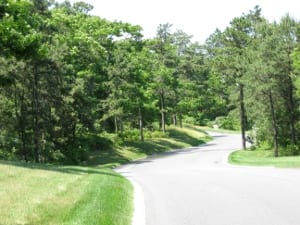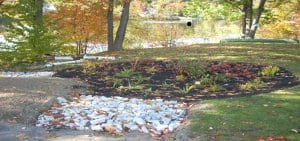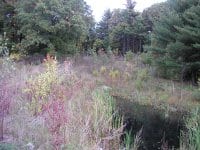Reviewed by Tara Mitchell
The Massachusetts Watershed Coalition’s recently released Community Guide to Growing Greener provides guidance and recommendations for stormwater management and better site design. The Guide is intended for developers, designers, community boards, and others, either required to meet stormwater regulations or simply seeking to implement Low Impact Development (LID) practices.
 The Guide provides a clear and easily accessible summary of many of the treatments discussed in greater detail in the MA Dept of Environmental Protection Stormwater Handbook. In addition to specific stormwater treatments, it includes a summary of recommended goals and objectives for Erosion and Sedimentation Control, Landscape Design, and Site Planning—all of which are integral to the overall goal of allowing development while protecting water, habitat, and the cultural and aesthetic characteristics of our towns.
The Guide provides a clear and easily accessible summary of many of the treatments discussed in greater detail in the MA Dept of Environmental Protection Stormwater Handbook. In addition to specific stormwater treatments, it includes a summary of recommended goals and objectives for Erosion and Sedimentation Control, Landscape Design, and Site Planning—all of which are integral to the overall goal of allowing development while protecting water, habitat, and the cultural and aesthetic characteristics of our towns.
The Guide is divided into five sections. Section I is a checklist for designers to help determine which treatments and practices might be most applicable or required for their particular project.
Section II, Stormwater Management, the bulk of the Guide, focuses on the ten most commonly used treatments, including swales, filter strips, constructed wetlands, bioretention cells, porous pavement, tree box filters, green roofs, and various types of basins. It provides an overview of site and design considerations, expected maintenance requirements, and TSS removal rates for each type of treatment. Photos help illustrate what each treatment will look like once constructed in the landscape.
Section III addresses Erosion and Sedimentation Control during the construction process. It discusses the importance of minimizing disturbance; soil stabilization through the use of mulching, plastic covering, planting, and seeding; sediment retention using riprap, check dams and ponds; and perimeter protections such as hay bales or compost filter tubes.
Section IV, Landscape Design, emphasizes three critical goals: stabilizing or reducing water use; minimizing habitat destruction and maximizing habitat value; and seeking to create landscapes that not only provide environmental benefit, but that are also aesthetically pleasing. Recommended objectives for water management include: retain and recharge water on site; protect and preserve existing quality vegetation and soil permeability to the extent possible; avoid irrigation or reduce requirements; minimize the use of turf grass by using plants instead; and mulch to protect soils and retain moisture. A variety of helpful plant lists are provided, including species native to the Wachusett region; salt, drought, and urban tolerant species; as well as lists of plants are that invasive and prohibited from sale in Massachusetts.

Pine Hills, Plymouth, MA demonstrates LID practices - reducing road width, preserving existing vegetation, and reducing turf grass area
The last section provides guidelines for Site Planning intended to encourage design strategies that protect the existing and future environment, result in visually appealing landscapes, and promote sustainable development. Guidelines include protecting existing natural and cultural site features, minimizing cutting and filling, locating houses and buildings so as to reduce their visual impact in the landscape and orienting them such that they take advantage of existing natural conditions (i.e., wind, sun) to maximize energy efficiency.
 The sixty-five page Guide successfully incorporates sufficient technical detail with general LID practices and objectives. It should prove a useful reference for individuals and communities seeking to not simply meet stormwater performance standards, but to also create attractive and sustainable landscapes that will bring greater benefit to the environment, the landowner, and the community at large. A Community Guide to Growing Greener is available online at: http://www.commonwaters.org/resources/community-guide-to-growing-greener.
The sixty-five page Guide successfully incorporates sufficient technical detail with general LID practices and objectives. It should prove a useful reference for individuals and communities seeking to not simply meet stormwater performance standards, but to also create attractive and sustainable landscapes that will bring greater benefit to the environment, the landowner, and the community at large. A Community Guide to Growing Greener is available online at: http://www.commonwaters.org/resources/community-guide-to-growing-greener.
About the Author
Tara Mitchell is a landscape architect with Massachusetts Department of Transportation. Her responsibilities include design, design review, and construction services for landscape restoration on transportation projects, including upland restoration and wetland and stream bank mitigation. Tara may be reached at tara.mitchell@state.ma.us.



